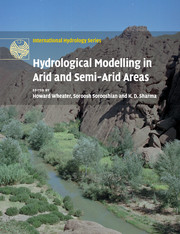Book contents
- Frontmatter
- Contents
- List of contributors
- Preface
- Acknowledgements
- 1 Modelling hydrological processes in arid and semi-arid areas: an introduction
- 2 Global precipitation estimation from satellite imagery using artificial neural networks
- 3 Modelling semi-arid and arid hydrology and water resources: The southern Africa experience
- 4 Use of the IHACRES rainfall-runoff model in arid and semi-arid regions
- 5 KINEROS2 and the AGWA modelling Framework
- 6 Ephemeral flow and sediment delivery modelling in the Indian arid zone
- 7 The modular modelling system (MMS): a toolbox for water and environmental resources management
- 8 Calibration, uncertainty, and regional analysis of conceptual rainfall-runoff models
- 9 Real-time flow forecasting
- 10 Real-time flood forecasting: Indian experience
- 11 Groundwater modelling in hard-rock terrain in semi-arid areas: experience from India
- Appendix Access to software and data products
- Index
- Plate section
- References
4 - Use of the IHACRES rainfall-runoff model in arid and semi-arid regions
Published online by Cambridge University Press: 15 December 2009
- Frontmatter
- Contents
- List of contributors
- Preface
- Acknowledgements
- 1 Modelling hydrological processes in arid and semi-arid areas: an introduction
- 2 Global precipitation estimation from satellite imagery using artificial neural networks
- 3 Modelling semi-arid and arid hydrology and water resources: The southern Africa experience
- 4 Use of the IHACRES rainfall-runoff model in arid and semi-arid regions
- 5 KINEROS2 and the AGWA modelling Framework
- 6 Ephemeral flow and sediment delivery modelling in the Indian arid zone
- 7 The modular modelling system (MMS): a toolbox for water and environmental resources management
- 8 Calibration, uncertainty, and regional analysis of conceptual rainfall-runoff models
- 9 Real-time flow forecasting
- 10 Real-time flood forecasting: Indian experience
- 11 Groundwater modelling in hard-rock terrain in semi-arid areas: experience from India
- Appendix Access to software and data products
- Index
- Plate section
- References
Summary
Streamflow in arid and semi-arid regions tends to be dominated by rapid responses to intense rainfall events. Such events frequently have a high degree of spatial variability, coupled with poorly gauged rainfall data. This sets a fundamental limit on the capacity of any rainfall-runoff model to reproduce the observed flow. The IHACRES model is a parameterically efficient rainfall-runoff model that has been applied to a large number of catchments covering a diverse range of climatologies. While originally designed for more temperate climates, the model has been successfully applied to a number of ephemeral streams in Australia. The recently released Java-based version of IHACRES (Croke et al., 2005, 2006) includes a modified loss module, as well as a cross-correlation analysis tool, new fit indicators and visualization tools. Additional advances that will be included in future releases of the IHACRES model include: an alternative non-linear loss module which has a stronger physical basis, at the cost of a slightly more complicated calibration procedure; a baseflow filtering approach that uses the SRIV algorithm to estimate the parameter values; a modified routing module that includes the influence of groundwater losses (subsurface outflow and extraction of groundwater); and a technique to estimate the response curve directly from observed streamflow data.
INTRODUCTION
Successful management of water resources requires qualitative analysis of the effects of changes in climate and land-use practices on streamflow and water quality.
- Type
- Chapter
- Information
- Hydrological Modelling in Arid and Semi-Arid Areas , pp. 41 - 48Publisher: Cambridge University PressPrint publication year: 2007
References
- 14
- Cited by

